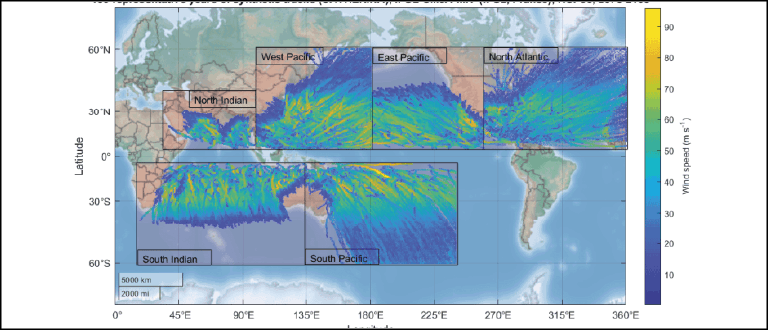GSF PAPER ON “CYCLONE GENERATION ALGORITHM FOR NATIONAL DAMAGE ASSESSMENT”
2022-11-07
One day after the opening of the 27th United Nations Climate Change conference (COP 27) in Sharm El Sheikh, Egypt, on November 6, the Green and Sustainable Finance (GSF) interdisciplinary research programme has one of its recent research papers published in the Geoscientific Model Development Journal, an interactive open-access journal of the European Geosciences Union.
The Cyclone Generation Algorithm for National Damage Assessment paper, written by Théo Le Guenedal, Philippe Drobinski, and Peter Tankov (Scientific Director of the GSF programme at Institut Louis Bachelier), focuses on the damage costs of tropical cyclones with the aim of including these advanced signals in integrated economic modeling.
More particularly, the objective of this paper is to fill the gap between climate models and integrated assessments: the authors build synthetic cyclones based on the climate data produced by the global climate models and evaluate the economic damage of these synthetic cyclones under various assumptions regarding the socioeconomic scenarios.
Tropical cyclones are responsible for a large share of global damage resulting from natural disasters, and estimating cyclone-related damage at a national level is a challenge attracting growing interest in the context of climate change. The global climate models, whose outputs are available from the Coupled Model Intercomparison Project (CMIP), do not resolve tropical cyclones.
The Cyclone generation Algorithm including a THERmodynamic module for Integrated National damage Assessment (CATHERINA), presented in this paper, couples statistical and thermodynamic relationships to generate synthetic tracks sensitive to local climate conditions and estimates the damage induced by tropical cyclones at a national level. The framework is designed to be compatible with the data from CMIP models offering a reliable solution to resolve tropical cyclones in climate projections. The authors illustrate this by producing damage projections in representative concentration pathways (RCPs) at the global level and for individual countries. The algorithm contains a module to correct biases in climate models based on the distributions of the climate variables in the reanalyses. This model was primary developed to provide the economic and financial community with reliable signals allowing for a better quantification of physical risks in the long term, to estimate, for example, the impact on sovereign debt.
Read the full paper directly on the Geoscientific Model Development website.
***
The Geoscientific Model Development is a not-for-profit international scientific journal dedicated to the publication and public discussion of the description, development, and evaluation of numerical models of the Earth system and its components.
Read the PDF